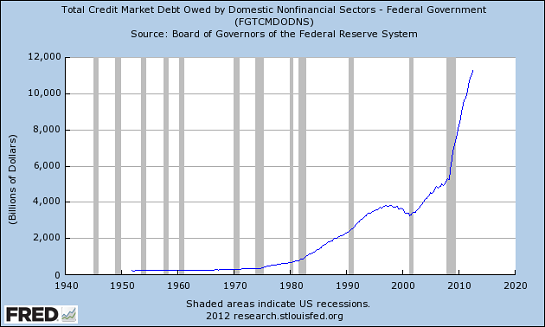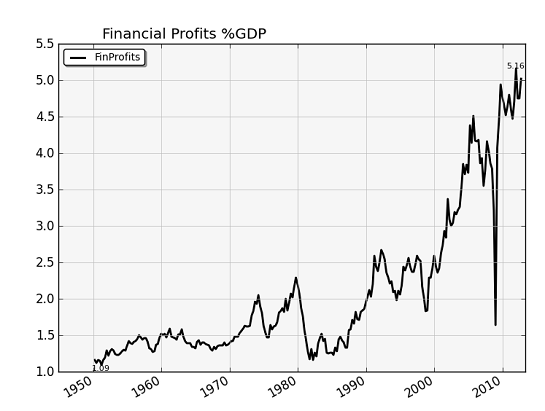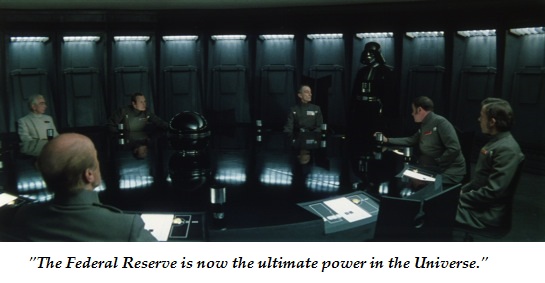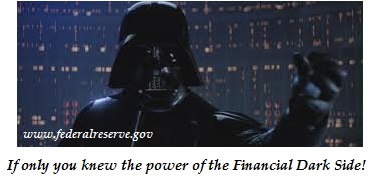Frequent contributor Jeff W. recently penned this succinct explanation of the Federal Reserve, and he did so with such clarity that in my view this is the essential primer on the Fed that every high school and college student in America should read. If they study this short essay, they will grasp the essence of the Fed and understand why the financial Status Quo is doomed.
People are confused about the Fed, and I think it would be better if everybody had a clear understanding of what the Federal Reserve is and what it is not.First of all, the Federal government thinks of the Federal Reserve as a service bureau, whose function it is to print money that the government can spend. As long as the Federal Reserve performs that function--reliably printing, let's say, a trillion or more each year to top off the Federal budget--then Congress will be happy with the Federal Reserve (their rainmaker) and will follow its advice and try to keep it happy.

It should be emphasized here that the whole Keynesian smokescreen and sideshow has very little to do with the reality of the relationship here. The Federal Reserve's job is not just to lend Uncle Sam some money during a recession so as to provide temporary stimulus. The Fed is a milk cow for Uncle Sam. Its job is to give milk all the time.
So to summarize this first point, the Fed is a service bureau for the Federal government whose job it is to provide the government with freshly printed fiat every year. This job has very little to do with the Keynesian prescription of how to deal with a recession.
The Fed is also a service bureau to the big banks that own it. Its job is to give unfair advantage to those banks, either by granting them low-interest loans that can be rolled over into infinity, or by buying their bad debts and disposing of them properly, or by doing any number of other special favors for them that increase their profits and executive bonuses. The Fed is not independent in the sense that it is self-governing. It must provide service to the banks who own it and to the Federal government, which controls its legal environment. Big banks have owned and controlled the Fed since its inception in 1913.
Summary: The Fed is also a service bureau to the big banks. It is not as independent as it proclaims itself to be; it provides services for its owners. Its owners have a profit motive.

The Fed also has its own institutional agenda. It wants to expand and increase its own power. It wants to operate in a safe and predictable environment. It wants to eliminate threats. The Fed advances its own agenda by printing or withholding money. As time goes on, the Fed has asserted more and more control over government. The Federal government is now addicted to freshly printed debt-money. This gives the Fed enormous power over the government.

The big banks who own the Fed also dominate Congress and the Obama administration due to the massive bribes they deliver each year. Thus over time the Federal Reserve has become more and more the master: what it wants it gets, what it doesn't want doesn't happen.
Summary: The Fed is also a selfish, power-seeking institution. It is not an organization of scientists (even though it does employ a small army of Economics Ph.D.'s) whose sole concern is to manage the economy scientifically for the benefit of all.

Some people think the Fed prints money, but when you ask Ben B. about it, he says, "The Fed does not print money. We lend money." Printing money is easy to visualize and understand. Lending money is also easy to understand; it's what banks do. But what the Fed does is somewhat more difficult to understand. To put it into one phrase, "they print debt-money." They print money, but each dollar they print has the chains of debt attached to it. Each dollar they print represents a debt that somebody owes.
A Federal Reserve note is an IOU from the Fed that says "we owe you one dollar." There does exist in the world paper money that is not debt-money, but the Fed does not traffic in that. As the Fed prints more debt-money, they tighten the chains of debt enslaving the government and the people.
A national debt of $1 trillion is manageable. It might be paid off in a few years. But a debt of $17 trillion is permanently enslaving (unless it is defaulted upon). Ben's printing press, then, is also an enslaving press. If Americans were to try to default on $17 trillion of debt, The Powers That Be would unleash their full wrath on the American people.
Summary: Ben B. runs a printing press that is also a debt-enslaving press. We are wrong to focus just on the inflationary effects of his money printing. We should also be alarmed by the enslaving effects.
The Fed has infinite fiat, though they try to disguise that fact. It takes no more effort for them to loan a trillion dollars than a million dollars. They will never run out of zeros in their computer system. The zero keys on their keyboards will always function. No matter how much they can print, they always have available an infinitely greater amount of fiat that they can still print. Printing money requires nearly zero effort and zero cost on their part. They don't get worn out from printing money.
This whole concept of infinite fiat is hard for people to grasp; it is something outside of their experience. People's lifelong experience with money is that it is a limited resource. It is hard to conceive of a group of people who have unlimited, infinite money. Yet the Federal Reserve has just that. The Fed is not like a doctor who prescribes a short-term stimulus for a patient who is feeling run down. The Fed is not like a parent who temporarily puts training wheels on a bike until the kid learns how to ride it. These metaphors make people think that the Fed's fiat printing is temporary and limited. It is not.
Read more at:-
http://www.washingtonsblog.com/2013/07/everyone-knows-that-the-federal-reserve-banks-are-private-except-the-american-people.html
No comments:
Post a Comment